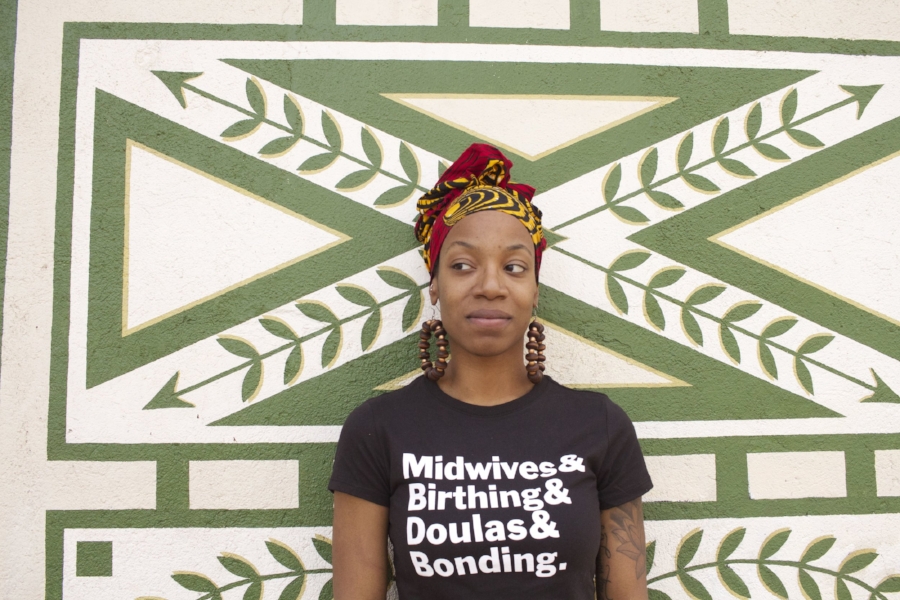July is Fibroid Awareness Month. This month, we’re answering all your questions about this uterine and reproductive health issue, from “Acessa vs. myomectomy: What’s the difference?” to “Why are Black women more prone to get fibroids?”
Brandi’s bloating was becoming unbearable.
She wore loose-fitting dresses to hide her swollen belly, but hadn’t found a solution for the intense pelvic pressure she felt every day. The 31-year-old’s personal life was suffering, too: sex was now incredibly painful.
Coworkers told her the bloating may be a side effect of working more overseas flights. Maybe you should drink more water, her fellow flight attendants suggested.
After her mother’s encouragement, Brandi made an appointment to see a gastroenterologist. Early in the appointment, it was clear something was wrong.
“Do you have your left ovary?” the technician asked as they rubbed the ultrasound wand over her belly. “Because it’s hard to find.”
When the gastroenterologist came in, she suggested that Brandi see her gynecologist: It looked like she had “loose blood” in her abdomen, she said.
I had to do some soul searching. I asked myself if having kids was so important to me that I wanted to keep my uterus.
Brandi already knew she had polycystic ovarian syndrome but a vaginal ultrasound soon revealed she also had fibroids (benign uterine tumors) and endometriosis, a painful uterine disorder.
While 80% of the people who are diagnosed with fibroids will never need surgery, Brandi wasn’t one of them. Weighing her options, she decided to have a laparoscopic myomectomy surgery to remove the tumors.
When Brandi woke up, she learned her OB-GYN was able to get all but one—a small straggler she didn’t think would cause a problem.
Four months later, after a weeks-long recovery from the surgery, Brandi began to bleed. It went from spotting to a heavy flow that lasted for months. Seeing that she was on continuous birth control at the time and hadn’t had a period in three years, this was especially alarming.
“My iron levels were so low, I had to get blood transfusions,” and take 16 pills a day to help stop the bleeding and to regulate her hormones, she recalls. The idea of doing another myomectomy was unbearable.
“I feel like the myomectomy brought me more problems than solutions,” she says. “I had to do some soul searching. I asked myself if having kids was so important to me that I wanted to keep my uterus. I got a lot of therapy, [and] used social media to speak out and share what I was going through.”
After researching fibroid treatment options, Brandi discovered a potential solution: Acessa.

Acessa: An Alternative Treatment for Fibroids
Created by OB-GYN Dr. Bruce Lee in 1999 and first tested in patients in 2000, the procedure has become an attractive alternative treatment for fibroids.
While not as well-known among fibroid sufferers as a myomectomy, it’s starting to gain attention as more and more people talk about their experiences with the procedure, piquing others’ interest.
When reproductive health and wellness expert Erica Chidi posted her fibroid and Acessa story on Instagram in August 2019, the post received hundreds of comments, many of them saying the same thing:
Thank you for sharing. I didn’t know about this. I wish I had known about Acessa sooner.
So what is Acessa?
Acessa is a FDA-cleared outpatient laparoscopic fibroid treatment. Using controlled heat, Acessa shrinks fibroids by breaking down the hard, dense tissue that makes up fibroid tumors so the body can reabsorb it.
While no procedure is 100% risk free, the fact that there’s an outpatient fibroid treatment that shrinks fibroids and can have you back at work in days rather than weeks deserves a strong look. (Especially in our community, as fibroids disproportionately affect Black women.)

Acessa vs. Myomectomy: What to Know
When deciding between Acessa and a myomectomy, it helps to know how each procedure is done.
During a myomectomy, your doctor removes fibroids either through an open, laparoscopic, or robotic surgery. In those surgeries, incisions are made in your abdomen and instruments are used to cut the fibroid out of your uterus and suture the incisions made on your uterus. (Myomectomies can also be done hysteroscopically, or through the vagina and cervix.)
With Acessa, three small incisions are made to your abdomen. Your doctor then inserts a radiofrequency tool called an array, a camera, and laparoscopic ultrasound through the incisions.
Acessa’s array applies controlled heat directly to each fibroid without damaging healthy uterine tissue, which means no uterine incisions or scarring. Instead of surgically removing fibroids, “we are turning the fibroid into a broken-down state that the body can recycle,” Dr. Lee explains.
Symptoms may improve after both procedures, but there is also the chance that fibroids… will return.
The camera and ultrasound provide greater visibility, so doctors can see every fibroid that needs to be treated—even small ones that are sometimes left behind with myomectomy.
“I am able to see, palpate, and treat very small uterine fibroids before they potentially cause symptoms,” says Dr. Lee. “I also treat some of the most advanced fibroid cases in the world. Acessa is effective for women that have very advanced fibroids ranging from fibroid size of a four-month pregnancy to a seven-and-a-half to eight month pregnancy.”
Treating smaller fibroids before they get large means the body has less material to reabsorb.
Dr. Lee has reported that in the first three months, the body will have reabsorbed about 20-25% of “the total amount that will be reabsorbed” has taken place. By six months, “80% of the total resorption has occurred.”
“With the larger tumors, the recycle rate is reduced,” he says. “I counsel patients that they should expect 60-80% fibroid size reduction, which is still good. I can’t control the reabsorption rate, that’s in the power of the uterus.”
Recovering from the Acessa procedure takes a few days to a week, with no heavy activity for three weeks. Myomectomy’s recovery time is about four to six weeks.
When considering Acessa vs. myomectomy, one can’t overlook the risks. You’ll need general anaesthesia for both, and that comes with its set of concerns. The procedures both have a lot of risks in common, including:
- scarring
- infection of or damage to surrounding organs, blood vessels, and nerves
- urinary tract infections
- temporary anemia
- rare instances where excessive blood loss could lead to the need for a hysterectomy.
Symptoms may improve after both procedures, but there is also the chance that fibroids (and the issues that come with them) will return. The recurrence rates for a laparoscopic myomectomy “were 15.3%, 43.8%, and 62.1% at postoperative years 1, 3, and 5, respectively,” according to a 2012 report in Gynecology and Minimally Invasive Therapy.
And while one can’t make an apples-to-apples comparison between the two (given Acessa’s relative newness and the lack of robust peer-reviewed data and research), in a clinical trial, Acessa’s recurrence rate was .7% after the first year and a cumulative 11% after three years, Dr. Lee reports.
Additional Considerations for Acessa vs. Myomectomy Treatment
In her 2019 post about Acessa, Erica Chidi alluded to an important part of her fibroid experience: her ability to pay for treatment.
“I wish more people knew about Acessa, and that more insurance companies covered it,” the founder and CEO of sexual and reproductive well-being company LOOM wrote. “Bureaucracy shouldn’t stand in the way of health.”
A treatment’s cost can’t be overlooked. It’s hard to nail down an average price for Acessa and myomectomy; so much depends on one’s insurance coverage, where they live, and the complexity of their case. MDSaves, a medical procedure cost-comparison tool, says that the national average cost for a laparoscopic myomectomy is $19,039. According to USA Fibroid Centers, Acessa costs $9,000-$15,000 out of pocket.
“Fortunately insurance coverage for Acessa is improving every year,” says Dr. Lee. (As of press time, Acessa is covered by Medicaid, Tri-Care, Aetna PPO, Cigna, and Blue Cross/Blue Shield of Illinois, Texas, Michigan, Oklahoma, New Mexico, South Carolina and Montana.)
Although Acessa is considered a less invasive alternative to a hysterectomy (the removal of one’s uterus) or myomectomy, it hasn’t been cleared by the FDA for those who want to conceive.
… New fibroids can develop after either procedure. The only guaranteed way to get rid of fibroids is through a hysterectomy.
“The FDA can’t clear something without data,” says Dr Lee. “I am working on a publication from my own patients who have conceived and delivered, but we need data from many physicians on pregnancy and pregnancy outcomes.”
The only procedure currently FDA cleared for pregnancy is myomectomy. However, many doctors will advise that patients should only deliver via C-section.
This is one of the reasons why Erica opted for Acessa instead of a myomectomy to treat 10 fibroids that had stretched her uterus to “the size of an 18-week pregnant womxn.”
“Myomectomies require uterine incisions [and] stitches, which means I’d have to have a cesarean birth, which didn’t bother me (all birth is natural™) but with current maternal health outcomes for Black women, I was hesitant to limit my autonomy, or increase interventions, in labor,” she wrote in her Instagram post.
Lastly, and unfortunately, new fibroids can develop after either procedure. The only guaranteed way to get rid of fibroids is through a hysterectomy.
“Overall 1 in 4 women who have a uterine-sparing procedure will need a hysterectomy sometime in her life,” says Dr. Ruth Arumala, an OB-GYN and a fibroid specialist.

Becoming Our Own Advocates
The more Brandi learned about Acessa, the more she was sure it was the right step for her.
“With fibroids, you already feel out of control,” she says. “Acessa gives women another option.”
Brandi reached out to get more information and was invited to a dinner with doctors to discuss her experience with fibroids. Afterwards, she encouraged her doctor to learn more about and get trained in the procedure.
“I trusted my doctor and wanted to feel like I was getting every option,” Brandi says now.
In December of 2019, Brandi became her OB-GYN’s first Acessa patient.
“My recovery from Acessa versus the myomectomy was night and day,” she says. “After three days I could drive, and I didn’t have to take any heavy pain medicine. I was back to work flying in one week.”
Although her first period after the treatment was heavy, her prolonged bleeding ended. She now takes a normal hormonal contraception dose and has a manageable three-day period.
When we speak up about our health, change can happen and countless others’ lives are improved.
And at her six-month checkup, the fibroid had shrunk to half its size.
Erica had a positive experience with Acessa as well.
“Within 24 hours, I was tender but walking,” she reported. “My two periods since are the first in recent memory that I didn’t have to change my cup, tampon or pad every hour, wake up to bloody sheets, or bleed through my clothes.”
What Brandi and Erica have modeled is how each of us can be our own health advocate. Understanding our bodies and our treatment options is crucial for well-being. We can get a second opinion. We can research treatment options and find doctors who support our wishes.
“My patients encouraged me to pursue procedures like this,” says Dr. Arumala of Acessa. “We need to offer all options.”
The more informed patients and health professionals are about fibroid treatment options, the more we’re able to live our lives to the fullest. One’s mental, physical, emotional, and reproductive health depends on being informed and having access to quality care.
In a perfect world, everyone would have information and equal access to the best fibroid treatment possible. Our world is far from perfect, though. But, as we each learn about how to better care for ourselves and share that insight with others, a ripple effect occurs.
When we speak up about our health, change can happen and countless others’ lives are improved.
















